Regional-based Pooled Funds

Natural hazards are severe and extreme weather and climate events. Although they occur in all parts of the world, some regions are more vulnerable to certain hazards than others. Natural hazards become disasters when people’s lives and livelihoods are destroyed. Every year, major earthquakes, floods, and hurricanes occur. These natural disasters disrupt daily life and, in the worst cases, cause devastation. Events such as the 2010 Haiti earthquake, the 2004 Indian Ocean earthquake and tsunami, the 2005 Hurricanes Katrina and 2012 Hurricanes Sandy killed thousands of people and generated billions of dollars in losses.
Millions of lives have been shattered every year by disasters such as drought, storms, earthquakes, landslides, and heatwaves that unleash dramatic levels of devastation. Although disasters are quick to strike, their consequences can linger for months and years. The Global Bank Regional Emergency Response Facilities (the “Faculty,” “GB-RERF,” or “RERF”) are primarily focused on what happens a day after "mega-disasters," catastrophic threats to individual cities, to countries, to a world region, and the entire globe. While meeting life-saving and life-sustaining needs, the GB-RERF together with the Global Bank Disaster Risk Reduction and Reconstruction Fund and Global Bank carries out research that helps prepare for, respond to, and recover from large-scale disasters — including hurricanes, earthquakes, nuclear accidents, pandemic flu, and terrorist attacks. The GB-RERF’s approach combines research, policy work, education, and high-level advocacy to ensure that the best thinking — and best practices — become part of disaster preparedness and recovery work. The rapid and flexible support offered by the Global Bank Regional Emergency Response Facilities makes it a central pillar of the Global Bank Group agencies’ humanitarian response architecture.
The Global Bank Regional Emergency Response Facilities works to understand and improve the nation’s capacity to prepare for, respond to and recover from disasters. GB-RERF focuses on the readiness of governmental and non-governmental systems; the complexities of population recovery; the power of community engagement; and the risks of human vulnerability, with a particular focus on the elderly, disabled and children.
The Global Bank Regional Standby Recovery Financing Facilities
The Global Bank Regional Emergency Response Facilities are regional Standby Recovery Financing Facilities (SRFF) that are dedicated funds set up by the Global Bank Group for the climate disasters prone regions. Regions such as the Global Bank Atlantic Recovery Fund (GBARF) which is a regional Standby Recovery Financing Facility (“SRFF”) dedicated to the Atlantic hurricane region including the North Atlantic Ocean, Caribbean Sea, and the Gulf of Mexico. It will provide for rapid and predictable disaster recovery operations, as a complement to the existing international coordination and financing instruments of various multilateral and bilateral agencies for this purpose. It will also act as an incentive for developing countries to invest in ex-ante risk management and disaster mitigation initiatives.
The Global Bank Regional Emergency Response Facilities supports, in a timely and sustained manner, the efforts led by disaster-stricken countries and regions for disaster risk reduction, in the post-disaster recovery and rehabilitation processes.
While meeting life-saving and life-sustaining needs, the Global Bank Regional Emergency Response Facilities is also focused on laying the foundation for long-term sustainable development. The Global Bank framework calls for actions to not only protect populations and promote quick recovery but also to prevent new risks, such as those caused by ill-planned urban growth in areas subject to flooding, landslides, and effects of climate change.
The GB-RERF Financing
The Global Bank Regional Emergency Response Facilities is funded through voluntary contributions. While the Global Bank Regional Emergency Response Facilities receives the bulk of its funding from governments, it also garners wide-range support from foundations, companies, charities, and individuals. Given the critical role that the Global Bank Regional Emergency Response Facilities plays in meeting complex humanitarian needs, its annual initial funding target is $1 billion per Facility per world region with the generous and consistent support of its donors.
Support Us
Please support global relief efforts by donating to the Global Bank Regional Emergency Response Facilities and allow humanitarian agencies to help people in need quickly and effectively. Your donation to the Global Bank managed humanitarian funds will be channeled through the Global Bank Disaster Risk Reduction and Reconstruction Fund – An Umbrella Trust Fund.
Ways to DONATE to the Regional Based Pool Fund
DONATE ONLINE NOW - select one of our campaigns below;
DONATE via BANK TRANSFER - If you would like to make a direct bank transfer, please contact the CERF Secretariat directly using this Contact Form
If you are interested in attending any of the Global Bank-led High-Level Donor Events and policy dialogs, please contact us using this form.
To learn more about the Global Bank Disaster Risk Reduction and Reconstruction Fund, What we do and How we do it and Management and Organization, visit the About DRRRF and the Frequently Asked Questions Section of the DRRRF Website Section.
For more information about the Global Bank, what we do and how we do it, please go to the About Us section of the Global Bank Website. http://www.global-bank.org

